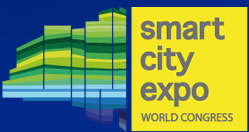Human beings will face the brink of extinction within 50 years, unless we start implementing the necessary measures to prevent our own demise as a species. This was the clear warning provided by Jeremy Rifkin, founder of the Foundation on Economic Trends, in a plenary session at the Smart City World Congress that was dedicated to energy sustainability in cities. According to Rifkin, the very future of our planet depends on the ability of these cities to connect every building into a global “Energy Internet”.
“What we need in the energy sector is the same type of revolution that has occurred over the past decade with personal computers and Internet in the arena of communication and shared knowledge.” Jeremy Rifkin, who conceived the theory of the Third Industrial Revolution, argued that we must change our mindset to seek an energy system that, analogously to the Internet, would be based on numerous connected nodes that are capable of production and distribution.
For Rifkin, the current crisis is not fundamentally economic; rather, it was born of the end of an energy consumption paradigm that has been in use for the past one and a half centuries. Hence, he believes that the strictly financial measures that have been proposed to solve the crisis will only provide short-term relief, at best.
Difficult, but not impossible
Rifkin is promoting a plan to spark what he calls the “Third Industrial Revolution”, a plan that he considers not only ecological, but also fundamentally economic. “The Third Industrial Revolution will provide the opportunity to create thousands of companies and millions of new jobs,” he stated. According to Rifkin, the technology required to bring his dream to fruition already exists: buildings and homes could be constructed such that they would not only be self-sufficient, but would also supply electricity to the central grid. Current storage problems would be overcome through use of hydrogen. Advances in information technology will enable the required level of intelligent connectivity among all the system components. Earth would generate enough renewable energy to fully satisfy human demands.
Rifkin feels that the mission will be difficult, but not impossible. “Looking at the infrastructure that we have been able to build during the last 50 years of the current Industrial Revolution, I don´t see why we can´t get this much-needed new Revolution up and running in less time,” he declared.
Are we on the right track to see Jeremy Rifkin´s ideas materialize? Can we improve Smart Cities through better energy management? “´Smart´ is not necessarily a positive adjective. Making the wrong things smart won´t get us anywhere,” argued professor Michael Braungart of Erasmus University, in Rotterdam. Like Rifkin, Braungart spoke of a new Industrial Revolution, although of one linked closely to product invention and design, rather than to energy.
The solution: mimic nature
Braungart is one of the principal minds behind Cradle to Cradle, a revolutionary new ecological philosophy that implies a radical shift in priorities and a novel concept of sustainability. Rather than seeking ways to minimize the environmental damage caused by human activity, followers of this school of thought aim for zero impact. Their solution is to copy nature-for example, when designing homes or products intended for daily use. “Nature does not think in terms of zero-emissions, nor does it generate useless waste,” pointed out Braungart, for whom cities, in this context, must reinvent themselves, by changing their goal from being “less bad for the environment” to “being good for the environment.”
Enric Ruíz-Geli, manager of Cloud 9, presented examples of how contemporary architecture could contribute to improved urban energy consumption, such as buildings that generate a “second skin” to protect themselves from exterior heat once a certain temperature threshold is reached; and “bright buildings”, which illuminate the streets that surround them.
Well-grounded projects
In contrast to the imaginative proposals described above, other participants presented more-grounded projects.
Tetsuya Nakajima, deputy executive director of the Climate Change Office for the city of Yokohama, described the measures that his city´s government has taken to reduce locally generated CO2 emissions.
Representatives from the companies AGABAR, FCC and Ferrovial explained how their respective firms perceive energy use in the context of Smart Cities, and described some of the measures that these firms are taking in this area. In most cases, these initiatives aim to improve management of distribution networks and obtain greater participation from residents and end-consumers.
Source: http://www.smartcityexpo.com



